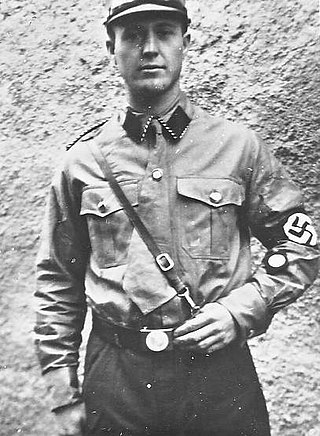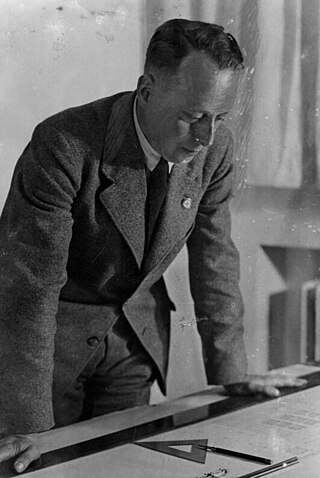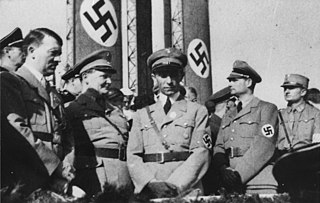Related Research Articles

Berthold Konrad Hermann Albert Speer was a German architect who served as the Minister of Armaments and War Production in Nazi Germany during most of World War II. A close ally of Adolf Hitler, he was convicted at the Nuremberg trials and sentenced to 20 years in prison.

The Hitler Youth was the youth organisation of the Nazi Party in Germany. Its origins date back to 1922 and it received the name Hitler-Jugend, Bund deutscher Arbeiterjugend in July 1926. From 1936 until 1945, it was the sole official boys' youth organisation in Germany and it was partially a paramilitary organisation. It was composed of the Hitler Youth proper for male youths aged 14 to 18, and the German Youngsters in the Hitler Youth for younger boys aged 10 to 14.

Organisation Todt was a civil and military engineering organisation in Nazi Germany from 1933 to 1945, named for its founder, Fritz Todt, an engineer and senior Nazi. The organisation was responsible for a huge range of engineering projects both in Nazi Germany and in occupied territories from France to the Soviet Union during World War II. It became notorious for using forced labour. From 1943 until 1945 during the late phase of the Third Reich, OT administered all constructions of concentration camps to supply forced labour to industry.

Fritz Todt was a German construction engineer and senior Nazi who rose from the position of Inspector General for German Roadways, in which he directed the construction of the German autobahns (Reichsautobahnen), to become the Reich Minister for Armaments and Ammunition. From that position, he directed the entire German wartime military economy.

Ranks and insignia of the Nazi Party were paramilitary titles used by the National Socialist German Workers' Party (NSDAP) between approximately 1928 and the fall of Nazi Germany in 1945. Such ranks were held within the political leadership corps of the Nazi Party, charged with the overseeing of the regular Nazi Party members.
National Socialist paramilitary ranks were pseudo-military titles which were used by the Nazis, represented by the Nazi Party, the National Socialist German Workers' Party, between the years of 1920 and 1945. Since the Nazi Party was by its very nature a paramilitary organization, by the time of the Second World War, several systems of paramilitary ranks had come into existence for both the Nazi Party itself and the various Nazi paramilitary organizations.

The National Socialist Motor Corps was a paramilitary organization of the Nazi Party (NSDAP) that officially existed from May 1931 to 1945. The group was a successor organisation to the older National Socialist Automobile Corps, which had existed since April 1930.

The ranks and insignia of the National Socialist Motor Corps were a paramilitary rank system in Germany used between the years of 1931 and 1945. They were based closely on the ranks and insignia of the Sturmabteilung (SA), of which the NSKK was originally a part.

Hermann Giesler was a German architect during the Nazi era, one of the two architects most favoured and rewarded by Adolf Hitler.

The Deutsches Jungvolk in der Hitlerjugend was the separate section for boys aged 10 to 13 of the Hitler Youth organisation in Nazi Germany. Through a programme of outdoor activities, parades and sports, it aimed to indoctrinate its young members in the tenets of Nazi ideology. Membership became fully compulsory for eligible boys in 1939. By the end of World War II, some had become child soldiers. After the end of the war in 1945, both the Deutsches Jungvolk and its parent organization, the Hitler Youth, ceased to exist.

Adolf Hühnlein was a German soldier and Nazi Party (NSDAP) official. He was the Korpsführer of the National Socialist Motor Corps (NSKK) from 1933 until his death in 1942.

The government of Nazi Germany' was totalitarian dictatorship governed by Adolf Hitler and the Nazi Party according to the Führerprinzip. Nazi Germany was established in January 1933 with the appointment of Adolf Hitler as Chancellor of Germany, followed by suspension of basic rights and the Enabling Act which gave Hitler's regime the power to pass and enforce laws without the involvement of the Reichstag or German president, and ended with Germany's surrender in World War II on 8 May 1945.
Edgar Joseph Alexandre Puaud was a French army officer, who, in 1945, briefly became commander of the Charlemagne Division, a French unit of the Waffen-SS in the service of Nazi Germany.

Franz Xaver Dorsch was a German civil engineer who became the chief engineer of the Organisation Todt (OT), a civil and military engineering group in Nazi Germany that was responsible for a huge range of engineering projects at home and in the territories occupied by the Germans during the Second World War. He played a leading role in many of the Third Reich's biggest engineering projects, including the construction of the Siegfried Line (Westwall), the Atlantic Wall and numerous other fortifications in Germany and occupied Europe. Following the war, he founded the Dorsch Consult consulting engineering company in Wiesbaden.
The comparative ranks of Nazi Germany contrasts the ranks of the Wehrmacht to a number of national-socialist organisations in Nazi Germany from 1933 to 1945 in a synoptic table. Nazi organisations used a hierarchical structure, according to the so-called Führerprinzip, and were oriented in line with the rank order system of the Wehrmacht.
Ranks and insignia of Organisation Todt show the pay grades, wage groups and paramilitary ranks used by the Organisation Todt.
In Nazi Germany, the Standarte was a paramilitary unit of Nazi Party (NSDAP), Sturmabteilung, NSKK, NSFK, and Schutzstaffel (SS). Translated literally as "Regimental standard", the name refers to the flag paramilitary formations carried in formations and parades.
Transportflotte Speer was a government owned waterways transportation company in Nazi Germany. At its creation it was tasked with the transportation of building material on the German inland waterways. During the war, it became subordinated to the Ministry of Armaments, and was given extensive coastal and inland transportation missions in occupied Europe, mainly in the service of Organisation Todt. The company was named after Albert Speer.
Transportkorps Speer was created in 1944 from Legion Speer and the units of the National Socialist Motor Corps that was serving the Organisation Todt. Shortly after its creation it became subordinated to the Wehrmacht. Yet, its major mission remained in support of OT, which at this time was mainly engaged in rebuilding and repair of bomb damaged industrial facilities and housing complexes. Transportkorps Speer was organized in motor transportation battalions and regiments, supported by depot, repair, engineering, signal, and medical units.
References
Notes
Cited literature
- Handbook of the Organisation Todt (1945), London: MIRS.
- Lepage, Jean Denis G. G. (2015). Hitler’s Armed Forces Auxiliaries. McFarland & Co.
- Seidler, Franz W. (1984), '"Das Nationalsozialistiche Kraftfahrkorps und die Organisation Todt im Zweitem Weltkrieg", Vierteljahrshefte für Zeitgeschichte 32(4): 625–636.
- Thomas, Nigel (1992), Wehrmacht Auxiliary Forces, London 1992.